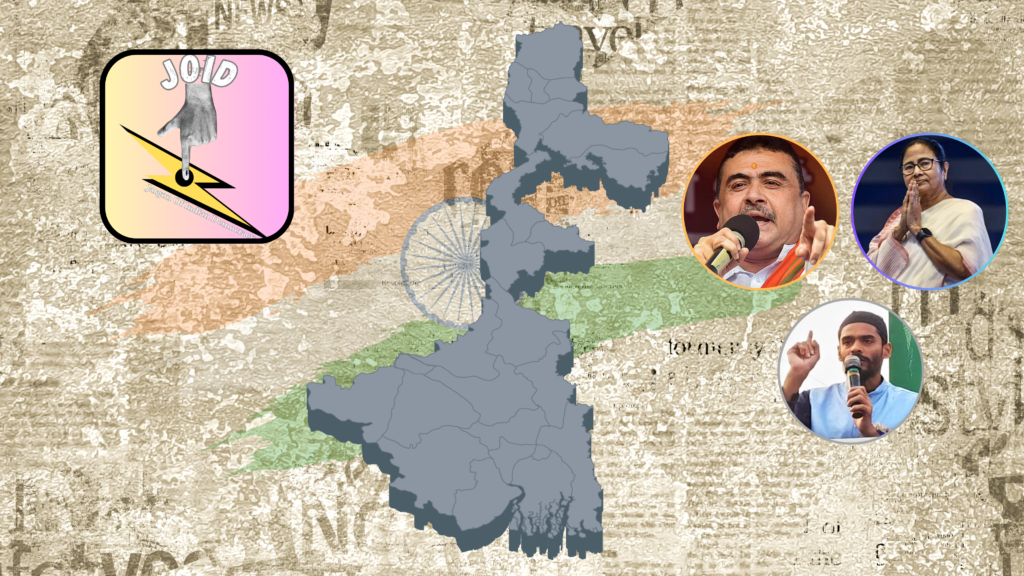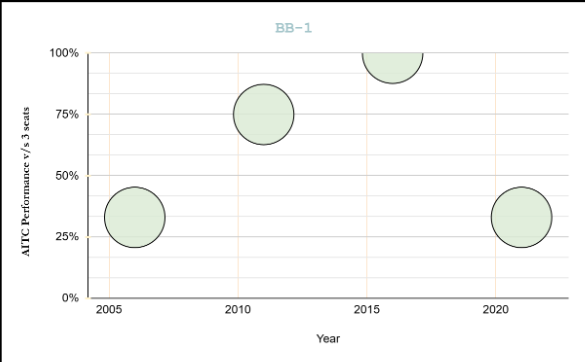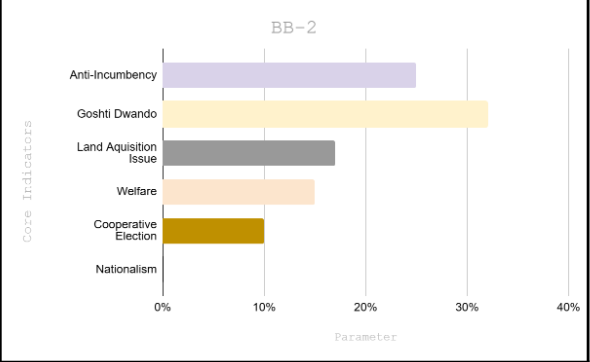
(This is a 3-part story to trace down seats (Bellwether) which become significant in West Bengal’s Electoral Appetite; The intent is to develop this in Phase-Wise and with different Geographic Domains and Political Economy to be covered with)
Introduction
In 1972, when the election during the emergency period was in full swing, the most unpredictable result was waiting at its cornerstone. Jyoti Basu (Former LOP and Ex-Dy CM) was going to lose his ancestral constituency, Baranagar, in a battle with the ideological companion from CPI. Like other allies and Left outfits, Basu himself withdrew his bid while the election was ongoing. Hence, this incident established a permanent rhetoric in Bengal’s electoral discussions. Jyoti Basu, whose next 30 years after this election were to be a Don Michael Corleone (Al-Pacino) type messianic existence in Indian politics, was once driven from his favourable seat, which translated to a 4-time win for him and his political supporters. The alternative that the electorate of Bengal once celebrated, which dominated urban hamlets, elected one of the most impactful MLAS in terms of development delivery. His name was Comrade Shibapada Bhattacharya from the Communist Party of India (CPI). It is also significant to note that during this period of emergency, when the CPI(M) led Left Front coalition opposed the INC (Indian National Congress), the mother faction was quite supportive of the INC and there is evidence that they conducted an international campaign with a pro-emergency stance. Since this historic event of defeat took place, 52 years later, this particular seat witnessed another watershed moment in its legislative journey when one of the most politically significant seats (Rajniti Sochetan as the common lingo in Bangla) elected its first woman legislator, who eventually became known as a star as well. The win of Sayantika Banerjee from this seat, now known as the 113-Baranagar Assembly Constituency, can be identified as the Bellwether Climax moment, similar to Smriti Irani’s in Amethi in 2019. This victory not only restored its former glory but also reflected the power and pressure that this constituency once harboured.
Definition:
Bellwether is a particular condition that is being discussed knowingly or unknowingly by all stakeholders in politics. It is widely used in the USA-Electorate discourse and Political Data. A bellwether condition refers to a geographic area whose political beliefs and voting preferences reflect those of a wider area. For example, a county may be said to be a “bellwether county” if it consistently votes the same way as the majority of the state. A state is considered a “bellwether state” if it usually votes the same way as a majority of the country. One famous example of a specific bellwether in politics is known as the “Missouri Bellwether,“ where the state of Missouri has voted for the presidential winner in every election from 1904 to 2016. Similarly, in our own country, there are many conditions that are close to this. For example, in Maharashtra, Baramati is a seat that defines the fate of the rule. The same goes for Amethi, Rai-Berali, and Ayodhya. At the same time, this trend was also followed in West Bengal, where seats with a history of representation defined the question of conquest.
Verdict of Bhangar vs Singur vs Nandigram:
To start this analogy, these three seats, representing the diversification of South Bengal, can serve as an immediate lens, located in different geographic and administrative structures (District). These three seats have distinct ethos and political histories. The political data and first-hand social accounts illustrate how social dialogues and public representation are determining the incumbency journey in the legislative electoral system. As can be observed, these three seats constitute only 1% of the total electoral mandate in West Bengal’s legislation and have consistently engaged in affairs such as the Peasant Movement, Secular Politics, and Social Hierarchy. During the tenure of 2007-2017, the first decade of AITC’s rise, these three seats were frequently highlighted in the news (print/electronic). Just as Competitive Democracy exists, terms like Competitive Anti-Incumbency/Competitive Mass Movement could also apply to the political-economic diaspora concerning these three seats.
What are the similarities among these three different geographic and administrative (read-Constituency) setups? Known as bastions of the peasant movement, these seats feature a unique caste composition, with Muslim, SC, and OBC voters playing pivotal roles as deciding factors.
In 2006, the last significant election where the Left Front performed well, two of these three seats were won by AITC. In Bhangar, Arabul Islam, and in Singur, Rabindranath Bhattacharya (aka Mastermoshai) were elected.
In 2011, this tally remained intact as AITC lost in Bhangar. In Nandigram, Sahid Janani Firoza Bibi won the seat. An important detail to note is that the principal Left-Front stakeholder, CPI(M), was contesting in only one-third of the seats.
Aside from this electoral historiography of 2006-2011, a common factor was the confrontation between the people and the police, which lasted until 2016. The Anti-Police People’s Committee, a coalition led by TMC Supremo Mamata Banerjee, actively operated in all three areas as an Anti-Left Resistance milieu. Additionally, land acquisition and SEZ were other factors to consider. With these similarities and patterns in mind, these three seats and their results will always serve as vantage points for the prime question: Who will run the state? Never in the past 20 years has AITC won all three of these seats in an election cycle, except in 2016, when this trend began to shift. With heterogeneous performances, it must be noted that all three seats have a unique presumption.

The tally shifted from 3-1, as CM Mamta Banerjee lost her combat in Nandigram with a slight margin of 1.8% vote share. This represents a condition as two prime Legislative Opposition forces are coming from the seats likely Nandigram (Suvendu Adhikari| LOP-Bengal Legislative Assembly | BJP) and Bhangar (Naushad Siddiqi | MLA |ISF). Eventually, the result happens in a manner that consists of a complete condition of the Bellwether equation while observing the State at large. Because of the defeat of these two seats and conceding victory of 1 seat-Singur (Becharam Manna | AITC) reflects a condition to be the most. If AITC lost Singur as a seat and won these two anti-incumbent hotspots, then the result might reverse its condition.
Status-Quo v/s In Action Bargaining: If it can be analysed, then the pattern has more to offer. A very traditional approach of: Status-Quo and In-Action conflict. As it is being observed, Singur has become a continuous example of being in a status quo, being the epicentre of the tri-crop region with all-season water facility, the common verdict gives a vibe that its proximity with AITC remains intact. The OBC+Brahmin voter cluster swung its allegiance only once in the 2019 Lok Sabha election. Where AITC saw a compact defeat in the seat. In a larger context, the grassroots coordination of AITC remains intact. Those 5 GPS-Ghaser Bheri, Singher Bheri and others remain an intact bastion for the Incumbent Party. Eventually, post-2010-2011, no major conflict took place in the region. Except for this, it seems the middle class dignity, which is completely controlled by the agrarian sufficiency, was another set of matters that worked as a quid pro quo for AITC in Singur. Needs and Expectations are in line with: Macro Development/Welfare Eco-System. This also seems that the Grassroot acceptance of: Bureaucracy v/s Governance v/s Local Party Structure. As it can be observed, the AITC’s structure of: Anchal President X Panchayat Pradhan | Block President X Block Sabhapati | MLA X ZP was coordinated in a manner that no major situational downfall was observed. Also, being an incumbent party, AITC performed well for the last 20 years in the local Cooperative Election. In Agrarian Hot beds, the Cooperative election is another significant threshold to prove the electoral capacity of a particular Political Outfit. As to close this remark on Singur, definitely need to recall Ex-CM Jyoti Basu’s remark when journalists asked him about the turbulence on land-acquisition is taking place. He told on camera, “What is our Kisan Sabha doing there?when this massacare was taking place”. The same throtolled in current Education Minister Bratya Basu’s voice where to recall the left regime he mentioned: “Back then the two words were significant and that are: Icchuk (willingly want to sale the land) and Onicchuk (not willingly want to sale the land)”.
While in Singur this became a pro-AITC model of winning the seat and translate it as the winning-bellwether a drastically different model is being shaped the nature of election. This often identified as anti-thesis. In its contemporary of people’s resistance, Nandigram found the headline with a prominent stand point. One of the main reason was the proposed investment where Daw Chemicals (Union Carbide) was a prime stakeholder. Post Bhopal Gas Tragedy, It often reflected that in Indian Civic Consideration there is completely no for some Industries. Chemical Industry and This Particular one is those primary organization involved in it. Keep it in side, The Nandigram episode become a blasphemy because Police Casuality and 144-Imposition. This created a callus move and post that after a blatant Sting-Operation orchestrated by a Journalist (who is then become the State President of TMC-Student wing and now with BJP), The political credibility started to shift in Nandigram. It was significant to mark, In the first All Party Meeting took place in-Mahajati Sadan at that time, Mamta Banerjee (Current CM and then Principle Opposition leader) was accompanied by Sisir Adhikary/Abu Taher and Sheikh Sufiyan. All of them are the core pillars of ‘Jonosadharoner’ Committee. After 12-13 years, The house got shifted in a manner. Suvendu Adhikari (The last disgruntled leader from AITC) started his campaign from Nandigram in September 2020. This began the next chapter of the next part of it, where Adhikari’s upsurge was astonishing. For more than 2 decades, Suvendu Adhikari remains the core confidante of CM-Mamta Banerjee started to agitate in the last leg of 2020. The agitation turned into a loaded battle when Mamta Banerjee herself declared her candidacy from Nandigram. This neck-to-neck battle became intriguing even after the result as well. Nandigram 2021, became CM-Mamta Banerjee’s Baranagar-1972 moment as she lost a straight election battle for the 2nd time in her Electoral career. However, this defeat only translates to a reverse moment of victory for her Party with a Thumping Majority. Many Electoral Intellectuals identified this as the PK Moment of Indian Politics. However, this hybridised a condition of Bellwether for the State context. Now, In this electoral cycle, also AITC will be desperate to loss this seat to continue their reverse luck.

The electoral chronology of Bhangar is in this chronology can be identified as the last but significant moment of the State’s anti-incumbency. With a very sound irrigational proponent and the perfect plain weather, Bhangar represents a different economic model for West Bengal. That eventually became the perfect Agro-Entrepreneurship model, which AITC led the Govt. want to promote as their adaptation. In the entire Eastern the FPC model incubated in Bhangar got a huge round of applause. This success with Small and Marginal Farmers gave this region a new height in Development Diaspora. However, at this same timeline, the region started to know a new set of social movements, where Climate Concern and Communist Vanguard took the show. CPI (Red-Star), a lesser-known alternative communist outfit, took this moment as a mark for their resistance. Eventually, they created an alternative Left imagination with the movement in Bhangar. The face of this movement, Alik Chakraborty, was highly regarded. Red-Star becomes relevant in an in-and-out potential. From 2016-2018,
It can be mentioned that the entire anti-establishment pro-peasant resistance imagination was aligned where this new left outfit was on the front line. This anti-establishment movement led model that Bhangar replicated was essentially a new non-partisan practice that started to shape in. This also got translated when Red-Star-backed representatives started to win Panchayat elections in 2018. To be noted at this particular time, Rejjak Mollah, the ardent critic of Ex-CM Buddhadev Bhattacharya and Current CM Mamta Banerjee, was with AITC. He won the seat in AITC’s ticket after 10 10-year timeline. Being a Land Revenue Minister in the Left Front Government and being known to be a leader of the Grassroots (Chashar Beta) he was also unable to control this situation. While this was happening, In 2020, twin brothers as Pirzada from the holy shrine hamlet Furfura started to reciprocate the muslim voter base under their umbrella. Soon, it transformed into a political platform supported by Left Front (mostly CPIM). This new party with a Conservative Outlook, known as: Indian Secular Front (ISF) fought the election from the Sanyukta Morcha’s side. This turned out that in Bhangar for the 2nd time, a non-mainstream Party received the mandate.
End Note: Traditionally, the identification of a bellwether seat has prioritised observable trends. However, this approach may not fully capture the complex and evolving nature of electoral dynamics. Viewing this concept through a contemporary lens offers a more nuanced and tenable exercise in understanding electoral behaviour. In the case of West Bengal, the elections of 2011 and 2021 serve as critical vantage points. Each marked a significant shift in political sentiment, carrying very different meanings for the electorate. Notably, the voter turnout in both elections was substantial, and the polling margin between the two major political parties hovered around 3.5% to 4%. Taking this as a baseline, concluding emerging bellwether trends may not be an overreach. While this analysis might contradict traditional expectations of bellwether outcomes, it reflects the evolving nature of electoral conditions. Context matters. Systems like first-past-the-post and proportional representation produce differing reflections of public choice, often lacking a uniform pattern. Looking ahead, the 2026 electoral exercise is expected to be more complex and competitive. As the political landscape becomes increasingly cluttered, it will be critical to observe how the three key constituencies behave—whether they conform to or defy the emerging bellwether narrative.
Our other articles : Why Congress must go solo in Bihar , Jai Bhim | Old is Gold , Resurrection of ‘Dynasty Politics’ , China Faces 125% Tariff by USA: A Strategic Opportunity for India, When the Accuser Becomes the Accused

Ishan Banerjee is an experienced professional serving as a mid-level manager and consultant portfolio. Over 10 years, he has worked in over 70+ districts across 8 states in the eastern, western and northeastern region of India, including Bihar, Jharkhand, Odisha, Chattisgarh , and West Bengal. He has also worked in diverse locations such as Punjab and Meghalaya. His areas of expertise include program management, data analysis, stakeholder liaison, research and development, program design, and program monitoring and evaluation.
